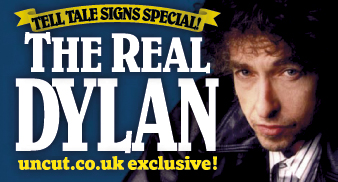BOB DYLAN SPECIAL: The Complete Tell Tale Signs
In this month’s issue of Uncut, we celebrate the release of Tell Tale Signs, the Bootleg Series Vol 8, Bob Dylan’s astonishing 2 and 3CD collection of unreleased material from 1989-2006.
We spoke to the musicians, producers and crew who worked with him during this period. And now, here’s your chance to read the full, unedited transcripts of those interviews.
Today, we present part 7; Augie Meyers‘ story about working on Love and Theft, while Daniel Lanois, Jim Keltner and others will follow in a further six parts in the coming weeks.
***
AUGIE MEYERS
First met Dylan in 1964, as part of Doug Sahm’s Sir Douglas Quintet. “Bob always liked us. We were one of his bands.” Dylan called for his “magic Vox” organ for Time Out Of Mind and “Love And Theft”.
I met Bob Dylan way back in 1964. Me and Doug Sahm we had the quintet in New York. And Bob always liked the Sir Douglas Quintet. We were one of his bands. That’s when we became friends. When he called me to play on the albums, he said, “Hey, bring your magic Vox,” that’s what he called my Vox organ. “Bring your accordion. We’ll try different things.”
Bob’s all work when he goes in the studio. He might stay in there for ten or twelve hours. The way you get started is, he just comes up and says, “Hey, let’s try this in this key.” He might change the key two or three times and do it different. I never really knew the titles to any of the songs. We were working on the songs, but he’d change the title, so I didn’t know what the songs were called until after the album came out. Bob actually called them “sketches.”
Bob’s a genius when he’s in the studio. He’s a great piano player; a lot of people don’t know that. It amazed me the way he could instantly change keys, hit all the chord changes. No matter what key he went into, he didn’t have to search for the chord, he could just go straight to it. He asked me one time, “How should I play this song?” I asked, “Did you write it on the keyboard or on the guitar?” He said, “Keyboard.” I said, “Well, you play it on the piano, you’ll feel more comfortable.” After we did the song, he said, “Man, you were right.”
When Daniel Lanois produced Time Out Mind, he wanted it a certain way. But Bob got his way. Bob asked me a couple of questions another time. He asked me, “How would you do this song if you and Doug Sahm did it?” And so I told him. And Daniel said, “Why are you answering the questions? I’m the producer.” I just said, “Hey, Bob asked me a question, so I’m gonna answer it.” Daniel said, “Well, I’m the producer.” And I said, “Hey, I don’t care. If he asks me a question, I’m gonna answer.”
The thing was, Daniel Lanois wanted to use his band on the session. And Bob wanted his friends. And so – Bob used his friends. I mean, everybody has their own ideas. Daniel wanted it one way, Bob wanted it another. But it came out like Bob wanted it. I did some records with Tom Waits, and I’d say they were something the same. They got out of you what they wanted. They’re both on the same level. Both genius. They had a certain sound or a certain feel that they heard, and, somehow, they got it out of you. Bob might say to me, “Hey, I hear Vox organ on this.” And I’d say, “Well, I hear an accordion.” And he’d say, “Well, I don’t hear no accordion.” So I’d say, “Lemme put it on there and see.” And after we got through, he said, “Man, leave it on there, I like it. That sounds great. I never thought about putting an accordion on.”
He gave me the run, y’know. He said, “I want you to play what you feel.” One time, though, I played a note, I did a little run on my keyboard, and he gave me a little look while we were recording. And when we got through, he said, “I’ve heard that sound, on ‘Like a Rolling Stone’.” And I said, “Yeah. That’s where I came from.” He said, “Yeah, well, we gotta do something different.” He just looked at me right away when I played it, he related to it right away.
When we did “Love And Theft”, we did it in New York, we’d work at night. I thought we’d have a producer, I was surprised, but I thought Bob did a great job producing it himself. He knew what he wanted to do. And he said it was a lot more comfortable. I mean, I think he enjoys making records, but he gets tired of all the hoopla, and everybody around him trying to put their two cents in.
My son played on “Love And Theft”, too. We went to see Bob in concert about two years ago. We were sitting in the audience listening to the show. My son said, “Didn’t we play on that song?” I said, “I don’t know. It don’t *sound* like the one we played on…” He changes his songs around all the time, they’re totally different. I guess he just gets bored doing them the same way, but sometimes the changes are a dramatic difference. Bob asked me to play on Modern Times, too, but I couldn’t do it because I was in Europe. But if he calls, I’ll be ready.
DAMIEN LOVE



